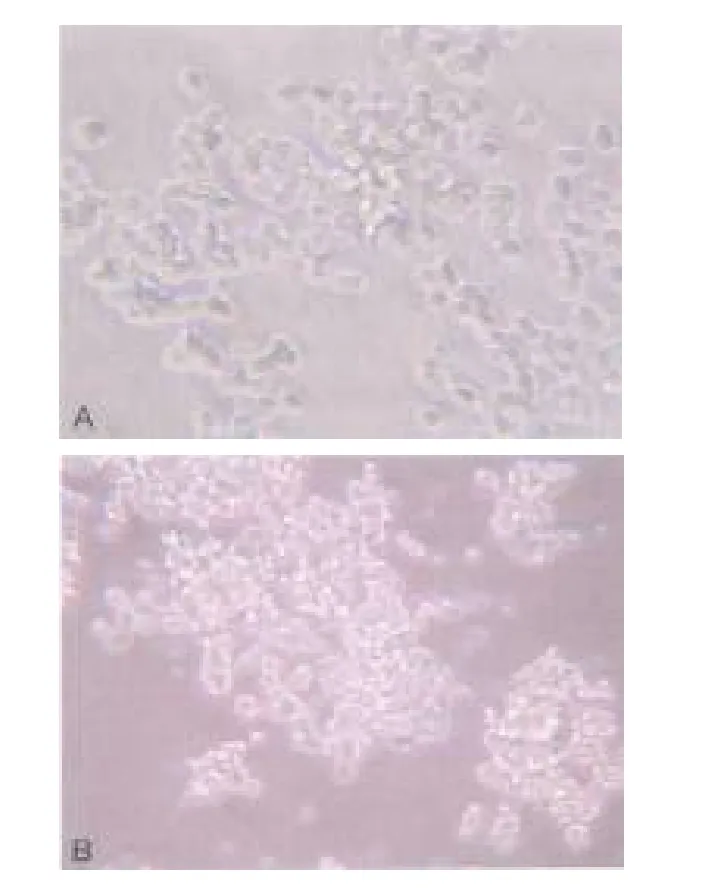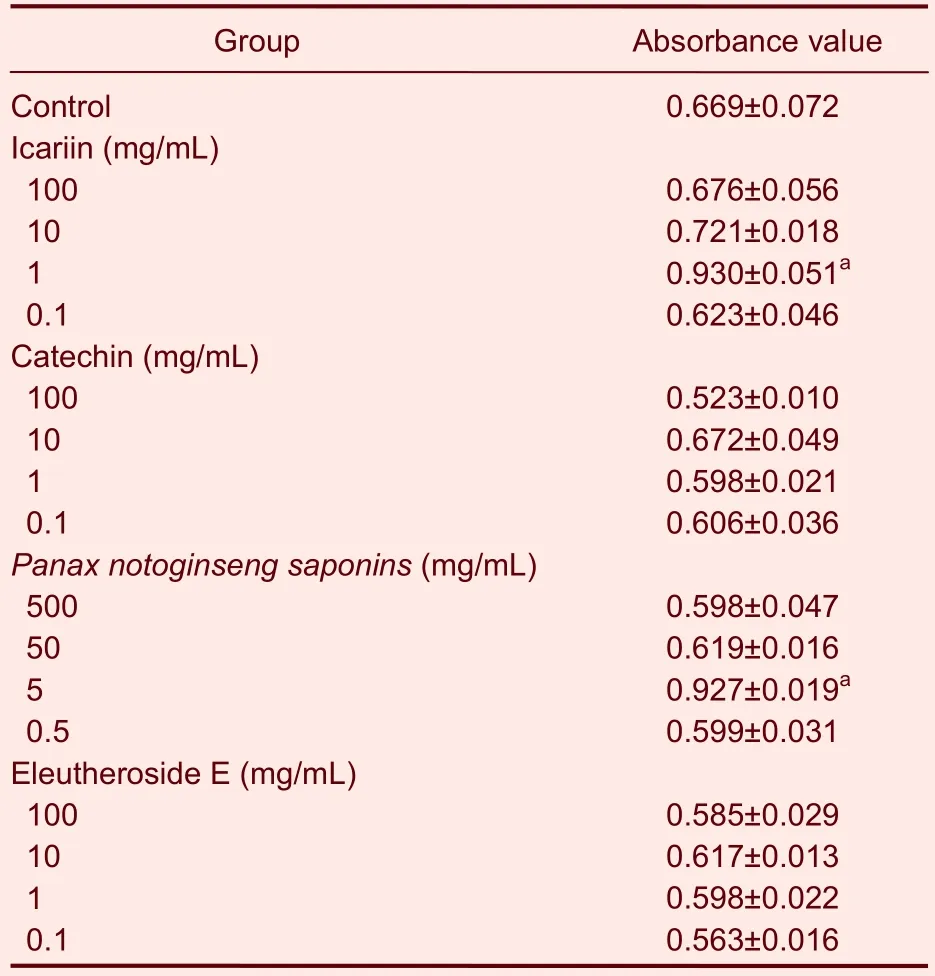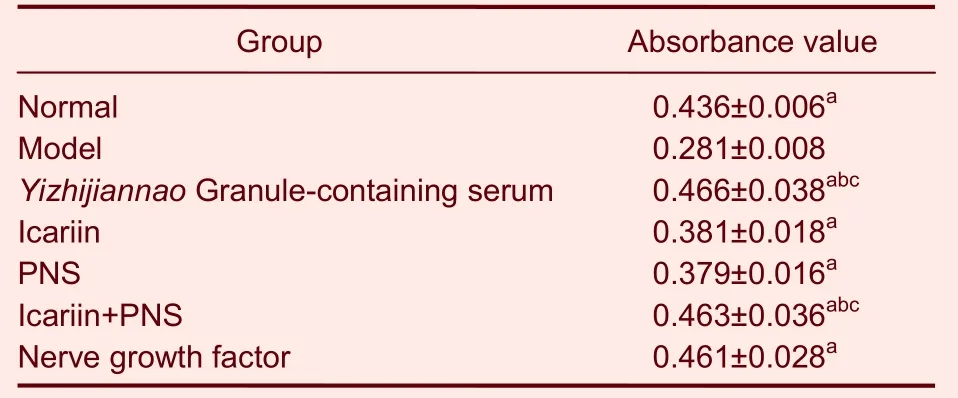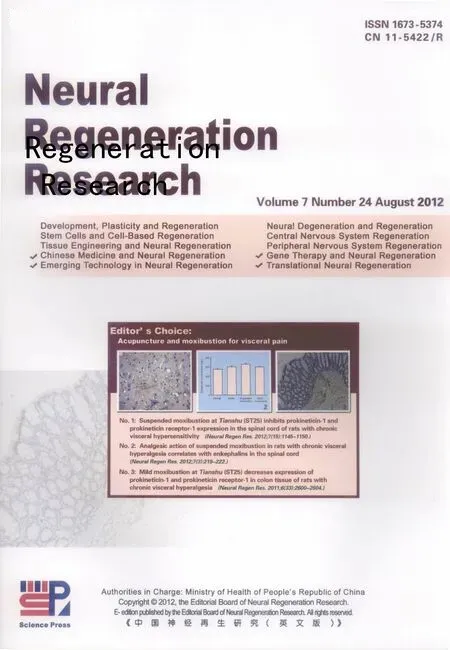Yizhijiannao Granule and a combination of its effective monomers, icariin and Panax notoginseng saponins, inhibit early PC12 cell apoptosis induced by beta-amyloid (25-35)☆
2012-09-12TingZhangZhanweiZhangKeliDongGuangchengLiHongZhu
Ting Zhang, Zhanwei Zhang, Keli Dong, Guangcheng Li, Hong Zhu
1 Department of Traditional Chinese Medicine, Xiangya Third Hospital, Central South University, Changsha 410013, Hunan Province, China
2 Department of Neurosurgery, First Affiliated Hospital of Hunan University of Chinese Medicine, Changsha 410007, Hunan Province, China
Yizhijiannao Granule and a combination of its effective monomers, icariin and Panax notoginseng saponins, inhibit early PC12 cell apoptosis induced by beta-amyloid (25-35)☆
Ting Zhang1, Zhanwei Zhang2, Keli Dong1, Guangcheng Li1, Hong Zhu1
1 Department of Traditional Chinese Medicine, Xiangya Third Hospital, Central South University, Changsha 410013, Hunan Province, China
2 Department of Neurosurgery, First Affiliated Hospital of Hunan University of Chinese Medicine, Changsha 410007, Hunan Province, China
Abstract
One of our previous studies showed that Yizhijiannao Granule, a compound Chinese medicine,effectively improved the clinical symptoms of Alzheimer’s disease. In the present study, we established a model of Alzheimer’s disease using beta-amyloid (25-35) in PC12 cells, and treated the cells with Yizhijiannao Granule and its four monomers, i.e., icariin, catechin, Panax notoginseng saponins, and eleutheroside E. Flow cytometry showed that Yizhijiannao Granule-containing serum,icariin, Panax notoginseng saponins, and icariin + Panax notoginseng saponins were protective against beta-amyloid (25-35)-induced injury in PC12 cells. Icariin in combination with Panax notoginseng saponins significantly inhibited early apoptosis of PC12 cells with beta-amyloid(25-35)-induced injury compared to icariin or Panax notoginseng saponins alone. The effects of icariin + Panax notoginseng saponins were similar to the effects of Yizhijiannao Granule. The findings indicate that two of the effective monomers of Yizhijiannao Granule, icariin and Panax notoginseng saponins, can synergistically inhibit early apoptosis of PC12 cells induced by beta-amyloid (25-35).
Key Words
Alzheimer’s disease; icariin; Panax notoginseng Saponins; Yizhijiannao Granule; Chinese medicine monomer; beta-amyloid protein; PC12 cell; Chinese medicine; neural regeneration
Research Highlights
(1) We screened for the effective concentration of four monomers of Yizhijiannao Granule.
(2) Two of the effective monomers of Yizhijiannao Granule, icariin and Panax notoginseng saponins,can synergistically inhibit early PC12 cell apoptosis induced by beta-amyloid (25-35).
Ting Zhang☆, Studying for doctorate, Attending physician, Department of Traditional Chinese Medicine, Xiangya Third Hospital, Central South University, Changsha 410013, Hunan Province,China
Corresponding author: Keli Dong, Master, Professor,Department of Traditional Chinese Medicine, Xiangya Third Hospital, Central South University, Changsha 410013, Hunan Province,China
dongkeli666@sina.com
Received: 2012-05-20 Accepted: 2012-07-22(N20120416002/WJ)
Zhang T, Zhang ZW, Dong KL, Li GC, Zhu H.
Yizhijiannao Granule and a combination of its effective monomers, icariin and Panax notoginseng saponins, inhibit early PC12 cell apoptosis induced by beta-amyloid(25-35). Neural Regen Res.2012;7(24):1845-1850.
www.crter.cn
www.nrronline.org
INTRODUCTION
Alzheimer’s disease is a multifactorial,complex disease[1-4]. Multiple target therapy is a novel idea for the treatment of complex diseases. The mechanisms of action of Chinese medicines involve multiple factors,which is consistent to a certain degree with multiple target therapy, and Chinese medicine has been a focus for drug development for complex diseases[5].Clinical studies showed that Yizhijiannao Granule, a compound Chinese medicine that can invigorate the kidney and promote blood flow, significantly improved cognition and daily life activities of Alzheimer’s disease patients, and significantly increased learning, memory and recall abilities of Alzheimer’s disease rats[6-8]. The mechanism of action of Yizhijiannao Granule may involve the inhibition of nervecell apoptosis, oxidative stress and inflammatory reaction in the brain, and the improvement of cholinergic system function and the regulation of β-amyloid protein[8-13]. Four representative components of Yizhijiannao Granule,Yinyanghuo, the primary active ingredient, Suoyang and Sanqi, secondary ingredients that help strengthen the action of Yinyanghuo, and Ciwujia (adjuvant drug), were selected to compare the neuroprotective effects of Yizhijiannao Granule and its active components. These active components are icariin, catechin, Panax notoginseng saponins, and eleutheroside E.
Drug-containing serum was used in an in vitro culture system designed to resemble the in vivo environment of cells, to ensure the consistency of experimental results and better reflect the effects of the drug treatments.However, in contrast with chemical drugs, the quality control of Chinese medicine compounds is complex. We screened effective monomers or monomer combinations from Yizhijiannao Granule to substitute for the complete and more difficultly controlled Yizhijiannao Granule.The present study established an in vitro cell model of Alzheimer’s disease induced by beta-amyloid (25-35) in PC12 cells. The influence of icariin, catechin, Panax notoginseng saponins and eleutheroside E on nerve cell apoptosis was evaluated and the neuroprotective effects of Yizhijiannao Granule, icariin, catechin, Panax notoginseng saponins and eleutheroside E were compared.
RESULTS
Verification of the Alzheimer’s disease cell model
PC12 cells were treated with beta-amyloid (25-35) to create an Alzheimer’s disease cell model. Inverted phase contrast microscopy showed that normal PC12 cells aggregated and were tightly connected. However, after beta-amyloid (25-35) treatment, the number of viable PC12 cells decreased, the cellular connection was no longer tight, the cytoplasm was dark, the number of cell fragments increased, adherent cells were not transparent,some cells shrank, and a large quantity of particles were observed in the cytoplasm (Figure 1).
Analysis of the effective concentration of the active monomers of Yizhijiannao Granule on cultured cells
Four concentrations of each monomer were used: 100,10, 1, and 0.1 mg/mL (icariin, catechin, and eleutheroside E) or 500, 50, 5, and 0.5 mg/mL (Panax notoginseng saponins). Compared with that of the control group (normal culture medium), PC12 cell viability (absorbance value in an MTT assay) was significantly enhanced after treatment with 1 mg/mL icariin or 5 mg/mL Panax notoginseng saponins (P <0.05), indicating that icariin and Panax notoginseng saponins can improve PC12 cell viability. However,PC12 cell viability remained unchanged in response to treatment with catechin and eleutheroside E for 24 hours(Table 1). Thus, 1 mg/mL icariin and 5 mg/mL Panax notoginseng saponins were used in subsequent experiments.

Figure 1 Morphology of PC12 cells in the model of Alzheimer’s disease (inverted phase contrast microscope,× 200).
Protective effects of Yizhijiannao Granule monomers on beta-amyloid (25-35)-treated PC12 cells
The Alzheimer’s disease cell model was treated with Yizhijiannao Granule-containing serum, icariin, Panax notoginseng saponins, icariin + Panax notoginseng saponins, or nerve growth factor (NGF, known to inhibit cell apoptosis, positive control). In addition, normal(normal culture) and model (Alzheimer’s disease model)groups were established. An MTT assay showed that PC12 viability (absorbance value) was significantly enhanced in the other groups compared with the model group (P < 0.01). PC12 viability (absorbance) was significantly enhanced in the Yizhijiannao Granule-containing serum and icariin + Panax notoginseng saponins groups compared with the icariin alone or Panax notoginseng saponins alone groups (P <0.05). There were no significant differences in the viability of the cells in the Yizhijiannao Granule-containing serum, icariin + Panax notoginseng saponins, and NGF groups compared with those in the normal group (P > 0.05; Table 2).

Table 1 Effects of the monomers of Yizhijiannao Granule on PC12 cell viability

Table 2 Effects of Yizhijiannao Granule-containing serum and the four monomers on the viability of PC12 cells treated with β-amyloid (25-35)
Effects of Yizhijiannao Granule-containing serum and the four monomers on the apoptosis of PC12 cells treated with beta-amyloid (25-35)
Annexin V-fluorescein isothiocyanate/propidium iodide staining flow cytometry showed that early PC12 cell apoptosis was significantly reduced in the other groups compared with the model group (P < 0.01). Early PC12 cell apoptosis was significantly reduced in the Yizhijiannao Granule-containing serum and icariin +Panax notoginseng saponins groups compared with the icariin or Panax notoginseng saponins groups (P < 0.05).There were no significant differences in the Yizhijiannao Granule-containing serum, icariin + Panax notoginseng saponins, and NGF groups compared with the normal group (P > 0.05; Table 3, Figure 2).

Table 3 Effects of Yizhijiannao Granule-containing serum and the four monomers on early apoptosis of PC12 cells treated with β-amyloid (25-35)
DISCUSSION
Results from the present study showed that the icariin +Panax notoginseng saponins mixture significantly enhanced PC12 viability compared with other monomers of Yizhijiannao Granule, with similar effects to Yizhijiannao Granule on protecting PC12 cells from beta-amyloid (25-35) injury. It is likely that (1) Chinese medicine compounds are commonly comprised of primary, secondary and adjuvant drugs, and some components of Chinese medicine are absorbed in the blood stream and become active after metabolism, so administration of the Chinese medicine compound often results in treatment effects in the whole body.(2) Monomers of Chinese medicine compounds interact synergistically, exhibiting superior effects over a lone monomer. (3) Some actual effective monomers may not have been found in the present study.Ginseng has been reported to promote icariin absorption and distribution, delay elimination, and effectively improve icariin bioavailability[14]. The major active component of ginseng is ginsenoside, and the major component of Panax notoginseng saponins also contains the ginsenoside Rg1. A previous study indicated that icariin plus Panax notoginseng saponins can reduce acetylcholinesterase activity in the brain tissues of beta-amyloid (25-35)-treated rats, improve learning, and inhibit the memory reduction induced by lateral ventricle injection of beta-amyloid (25-35)[15]. Icariin plus Panax notoginseng saponins can also attenuate oxidative stress injury induced by beta-amyloid (25-35) in the hippocampal CA1 of rats and improve their learning and memory[16]. The present study established an in vitroAlzheimer’s disease cell model and determined cell viability and the extent of early apoptosis using an MTT assay and Annexin V-fluorescein isothiocyanate/propidium iodide staining.

Figure 2 PC12 apoptosis by flow cytometry.
Results from both methods showed that the combination of monomers of icariin and Panax notoginseng saponins exerted similar effects to Yizhijiannao Granule with regard to the inhibition of beta-amyloid (25-35)-induced early PC12 apoptosis and the protection of PC12 cells from beta-amyloid(25-35)-induced injury, indicating synergistic effects of icariin and Panax notoginseng saponins. Icariin plus Panax notoginseng saponins may have multiple-layer and multiple-target effects in Alzheimer’s disease treatment. The present study provides a reference for the development of drugs to substitute for Yizhijiannao Granule for the prevention and treatment of Alzheimer’s disease.
MATERIALS AND METHODS
Design
A comparative observation and in vitro cytology study.
Time and setting
The experiment was performed in the Laboratory of Neurobiology, Xiangya School of Medicine, Central South University, China from May 2010 to March 2011.
Materials
Animals
A total of 40 healthy male Sprague-Dawley rats, aged 3 months, weighing 300 ± 20 g, were purchased from the Department of Laboratory Animal Science, Xiangya School of Medicine, Central South University and housed in the Department of Laboratory Animal Science,Xiangya School of Medicine, Central South University.Animal procedures were performed in accordance with the Guidance Suggestions for the Care and Use of Laboratory Animals, issued by the Ministry of Science and Technology of China[17].
Drugs
Yizhijiannao Granule was composed of 15 g Yinyanghuo, 15 g Suoyang, 10 g Sanqi, 10 g Ciwujia,10 g Radix Dipsaci from Sichuan, China, 10 g Baiziren and 5 g Shuizhi. The crude drugs were purchased from the Dispensary of traditional Chinese medicine,Xiangya Third Hospital of Central South University,China, and identified by the Laboratory of Chinese Medicine Pharmacology, Xiangya Third Hospital of Central South University. All components were mixed,water-extracted, condensed, and dried to prepare a dry extract. Each kind of Chinese medicine was prepared as 25 g granules, and each milliliter of concentrated solution (from which water was extracted) contained 3 g of crude drugs. The icariin, catechin, Panax notoginseng saponins and eleutheroside E content was controlled using high-performance liquid chromatography according to the Chinese Pharmacopoeia[18]. During drug preparation, the quality of the drugs was strictly monitored by Hunan Dekang Pharmaceutical Co., Ltd., Hunan, China.Monomers of icariin, catechin, Panax notoginseng saponins and eleutheroside E were purchased from Beijing Heng Yuan Qi Tian Institute of Chemical Technology, China, with the purity of all drugs > 98%.
Cell line
Undifferentiated PC12 cells (a rat adrenal gland pheochromocytoma cell line with characteristics typical of nerve cells) were purchased from the Institute of Biochemistry and Cell Biology, Shanghai Institutes for Biological Sciences, Chinese Academy of Science.
Methods
Preparation of beta-amyloid (25-35)
beta-amyloid (25-35) (Sigma, St. Louis, MO, USA) was dissolved in PBS to a concentration of 250 μM, incubated at 37°C for 4 days until aggregated, and stored at -80°C.
Establishment of the Alzheimer’s disease cell model The Alzheimer’s disease cell model was established as previously described[19-20]. Briefly, PC12 cells were incubated with 20 μM beta-amyloid (25-35) for 24 hours.PC12 cells were seeded in a 24-well plate. Cell morphology was observed with an inverted phase contrast microscope (Nikon, Tokyo, Japan).
Preparation of Yizhijiannao Granule-containing serum
The 40 3-month-old male Sprague Dawley rats were randomly assigned to Yizhijiannao Granule-containing serum and blank serum groups, with 20 animals in each group. The rats in the Yizhijiannao Granule-containing serum group were intragastrically perfused with Yizhijiannao Granule-containing serum at a dose according to the body surface area formula[21], 4.5 g/d each. The blank serum group was intragastrically perfused with an equal volume of normal saline. Both groups were perfused twice daily for 5 consecutive days.Blood was harvested from the femoral artery 1 hour following the final perfusion, and serum was isolated in a sterile manner, filtered, and sterilized.
Screening for the effective concentration of the four monomers
Four concentrations of each monomer were used: 100,10, 1, and 0.1 mg/mL (icariin, catechin, and eleutheroside E ) or 500, 50, 5, and 0.5 mg/mL (Panax notoginseng saponins). The absorbance value of each well was determined after PC12 cells were cultured with each monomer for 24 hours using an MTT assay[22].
Drug treatment of beta-amyloid (25-35)-treated PC12 cells
PC12 cells were cultured in a culture flask and triturated when the cells grew into a single layer. The concentration was adjusted to 105cells/mL and seeded in a 96-well plate, with 100 μL in each well. Normal group cells were cultured in Ham’s F-12 medium (Hyclone, Logan, Utah,USA) containing 5% fetal bovine serum (Gibco,Gaithersburg, MD, USA) and 15% horse serum(Hyclone). The cells in the Yizhijiannao Granule-containing serum, Chinese medicine monomer and NGF groups were treated with the corresponding drugs while in the logarithmic phase. The screening concentrations mentioned previously were used, with five parallel wells at each concentration; 10 mg/L NGF(Promega, Madison, WI, USA) was added to the NGF group for 2 hours. Each group was treated with beta-amyloid (25-35) for an additional 24 hours. Cell viability was determined using an MTT assay[22], and the early apoptosis rate was detected using flow cytometry(Becton Dickinson, San Jose, CA, USA).
Detection of PC12 cell apoptosis using Annexin V-fluorescein isothiocyanate/propidium iodide staining flow cytometry
The early apoptosis rate of PC12 cells was detected using Annexin V-fluorescein isothiocyanate/propidium iodide staining flow cytometry (Becton Dickinson)according to the Annexin V-fluorescein isothiocyanate kit(Bender Med Systems, Vienna, Austria). Cells from each group were collected, rinsed with PBS, centrifuged,washed once with diluted binding buffer solution (20 mM Tris, 250 mM NaCl, 1 mM ethylenediaminetetraacetic acid, 0.5% NP-40 and protease inhibitor, diluted 5 times),and the cell concentration was adjusted to 1 × 106/mL using the above buffer solution, mixed evenly with 5 μL diluted Annexin V-fluorescein isothiocyanate and 10 μL propidium iodide, incubated in the dark for 10 minutes and detected by flow cytometry. Cells were collected using Cell Quest software (Becton Dickinson) and 1 × 105cells from each sample were detected. Results were represented as the percentage of positive cells(%). Data were analyzed using Cell Quest Plot software.A scatter plot was made with fluorescein isothiocyanate and propidium iodide fluorescence intensity as parameters.
Statistical analysis
Measurement data were expressed as mean ± SD and analyzed using SPSS 15.0 software (SPSS, Chicago, IL,USA). Intergroup means were compared using one-way analysis of variance, and paired comparisons of intergroup data differences were conducted using a Student-Newman-Keuls test. The alpha level was α =0.05.
Acknowledgments: We thank Zhiqiang Xiao, Fang Peng and Cui Li, from the Laboratory of Tumor Proteomics, Xiangya Hospital, as well as Xiaowei Xing of the Central Laboratory of Xiangya Hospital, for technical support. The authors also thank Yan Chen of the Laboratory of Tumor Proteomics, XiangyaHospital for the help.
Author contributions: Ting Zhang conceived and designed the study, analyzed data, and wrote the manuscript. Zhanwei Zhang integrated and provided experimental data. Keli Dong revised the manuscript and guided the study. Guangcheng Li provided technical support and guided the study. Hong Zhu analyzed experimental data.
Conflicts of interest: None declared.
REFERENCES
[1] Palop JJ, Chin J, Mucke L. A network dysfunction perspective on neurodegenerative diseases. Nature.2006;443(19):768-773.
[2] Castellani RJ, Zhu XW, Lee HG. Molecular pathogenesis of alzheimer disease: reductionist versus expansionist approaches. Int J Mol Sci. 2009;10(3):1386-1406.
[3] Noorbakhsh F, Overal CM, Power C. Deciphering complex mechanisms in neurodegenerative diseases:the advent of systems biology. Trends Neurosci. 2009;32(2):88-100.
[4] Villoslada P, Steinman L, Baranzini SE. Systems biology and its application to the understanding of neurological diseases. Ann Neurol. 2009;65(2):124-139.
[5] Kitano H. A robustness-based approach to systemsoriented drug design. Nat Rev Drug Discov. 2007;6(3):202-210.
[6] Zhang T, Dong KL. Effect of Yizhijiannao-granule on expression of β-amyloid protein in patients with Alzheimer’s Disease. Zhongguo Laonianxue Zazhi.2007;27(11):1080-1081.
[7] Yang P, Dong KL, Zeng WY. Influences of traditionalm edicine Yizhijiannaokelion behavior of SAMP8. Zhongguo Laonianxue Zazhi. 2009;29(1):33-35.
[8] Yang P, Dong KL, Zeng WY. Effect of yizhi jiannao granule on the behavior and neuron apoptosis in SAMP/8 mice.Zhongnan Daxue Xuebao: Yixue Ban. 2006;31(1):56-59.
[9] Jiang MY, Dong KL, Xiao L, et al. Effect ofY izhijiannao-granule on expression of hippocampus proteomics in senescence accelerated mouse-8.Zhongguo Laonianxue Zazhi. 2009;29(1):33-35.
[10] Wang HL, Dong KL, Li GC, et al. Effect of yizhi jiannao granules on the expression of Pin1 and HMGB1mRNA in the hippocampus of SAMP8 mice. Zhongnan Daxue Xuebao: Yixue Ban. 2009;34(1):63-66.
[11] Gong CL, Dong KL, Li GC, et al. Effect of Bushen Huoxue representative prescription Yizhi Jiannao granule on AD rats’ cognition and memory ability and the expression of ChAT and TrkA in hippocampus CA1. Hunan Zhongyi Zazhi. 2009;25(3):109-110.
[12] Liu P, Dong KL. The effect of Yizhi Jiannao granule on IL-1β and TNF-α exp-ression in peripheral blood serum in patients with alzheimer’s disease. Hunan Zhongyi Zazhi.2010;26(5):1-3.
[13] Zhang T, Dong KL, Li GC. Effect of Yizhi Jiannao granule concentration fluid on the differential expression protein in entorhinal area tissue of senescence accelerated mouse P8. Zhongguo Zhong Xi Yi Ji He Za Zhi. 2010;30(5):504-508.
[14] Zou JM, Meng J, Yan ZH, et al. Pharmacokinetic studies of icariin in Chinese formulated medicine. Zhong Cao Yao.2002;33(1):55-58.
[15] Xiao XF, Zheng M, Qu LH. Effects of icariin combined with the Panax notoginseng saponins on behavior and acetylcholinesterase activity induced by β-amyloid peptide25-35 lateral ventricle injection in rat. Zhongguo Xian Dai Ying Yong Yao Za Zhi. 2005;22(3):178-181.
[16] Zeng M, Qu L, Lou Y. Effects of icariin combined with Panax notoginseng saponins on ischemia reperfusion-induced cognitive impairments related with oxidative stress and CA1 of hippocampal neurons in rat.Phytother Res. 2008;22(5):597-604.
[17] The Ministry of Science and Technology of the People’s Republic of China. Guidance Suggestions for the Care and Use of Laboratory Animals. 2006-09-30.
[18] Zeng YE. Chinese Pharmacopoeia. Guangzhou: Sun Yat-sen University Press. 2011.
[19] Luo M, Xie RM. Apoptosis of PC12 cell induced by amyloid beta-peptide fragment 25-35. Fudan Xue Bao Yi Xue Ban. 2004;31(6):618-621.
[20] Hosoda T, Nakajima H, Honjo H. Estrogen protects neuronal cells from amyloid beta- induced apoptotic cell death. Neuroreport. 2001;12(9):1965-1970.
[21] Xu SY, Bian RL, Chen X. Pharmacology Experiment Methodology. 3rded. Beijing: Peoples Medical Publishing House. 2002.
[22] Kaikabo AA, Samuel BB, Eloff JN. Isolation and activity of two antibacterial biflavonoids from leaf extracts of Garcinia livingstonei (Clusiaceae). Nat Prod Commun.2009;4(10):1363-1366.
(Edited by Yu DW, Cai WJ/Su LL/Wang L)
10.3969/j.issn.1673-5374.2012.24.001
杂志排行
中国神经再生研究(英文版)的其它文章
- Effects of wind-dispelling drugs and deficiency-nourishing drugs of Houshiheisan compound prescription on astrocyte activation and inflammatory factor expression in the corpus striatum of cerebral ischemia rats****☆
- Acupuncture and moxibustion for visceral pain
- Therapeutic effect of nerve growth factor on cerebral infarction in dogs using the hemisphere anomalous volume ratio of diffusion-weighted magnetic resonance imaging*★
- Pre-ischemia electro-acupuncture potentiates the expression of Bcl-2 and transforming growth factor-beta 1 in rat brains*☆△◇
- Acupuncture activates signal transduction pathways related to brain-tissue restoration after ischemic injury**☆
- No association between a polymorphism of the adenylate cyclase type IX gene and major depressive disorder in the Chinese Han population*☆
